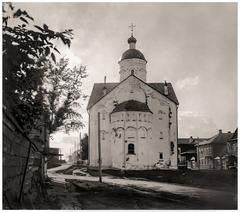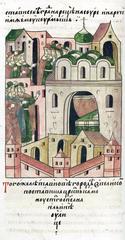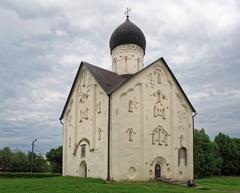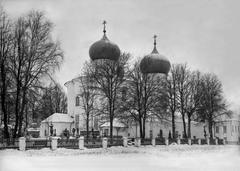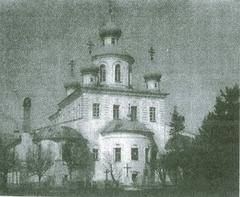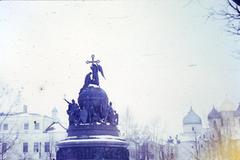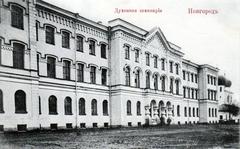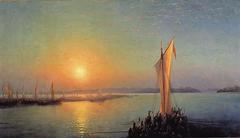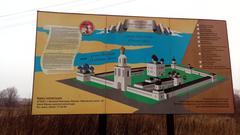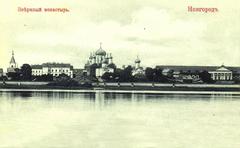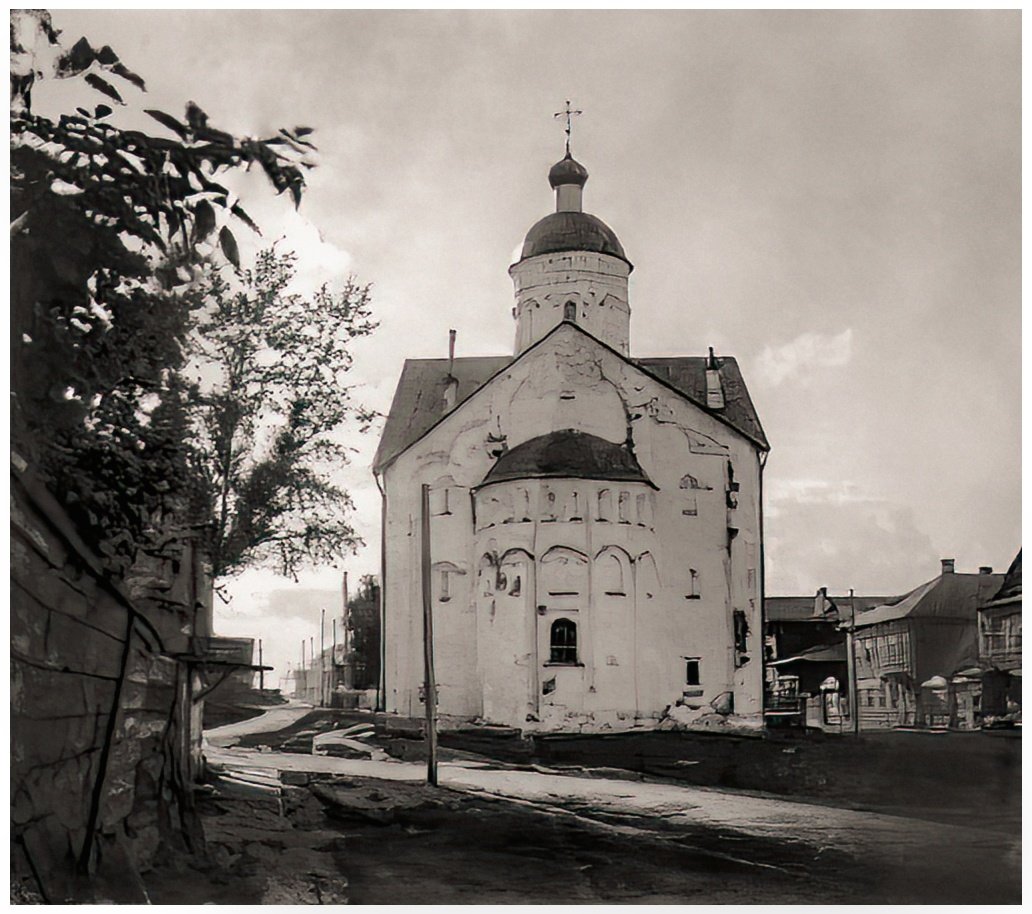
Visiting Церковь Спаса Преображения на Ильине улице: History, Tips, and Visitor Information
Date: 31/07/2024
Introduction to the Church of the Transfiguration on Ilyina Street
Церковь Спаса Преображения на Ильине улице, known in English as the Church of the Transfiguration of the Savior on Ilyina Street, is a remarkable historical and architectural monument situated in Veliky Novgorod, Russia. Constructed in 1374, this church stands as a testament to the rich cultural and political history of medieval Novgorod. Commissioned by the influential Novgorod boyar Vasily Danilovich, the church exemplifies the Novgorod school of architecture with its use of brick and stone and its distinctive decorative elements. A significant highlight of the church is its interior frescoes painted by the renowned Byzantine artist Theophanes the Greek in 1378. These frescoes, including the famous ‘Transfiguration of Jesus,’ are celebrated for their expressive figures, dynamic compositions, and vibrant colors, showcasing a blend of Byzantine traditions and local artistic elements. Recognized as a UNESCO World Heritage Site, it continues to attract tourists, art historians, and religious pilgrims from around the world (Visit Novgorod).
Table of Contents
- Introduction
- Historical Background
- Visitor Information
- Preservation and Restoration
- Modern-Day Relevance
- Conclusion
- FAQ
- Call to Action
Historical Background
Origins and Construction
The Church of the Transfiguration of the Savior on Ilyina Street is a significant historical and architectural monument located in Veliky Novgorod, Russia. Constructed in 1374, during the period when Veliky Novgorod was a major political and cultural center in medieval Russia, it was commissioned by the Novgorod boyar Vasily Danilovich, a prominent figure in the city’s history.
The church is a prime example of the Novgorod school of architecture, characterized by its use of brick and stone, as well as its distinctive decorative elements. The structure features a single-domed, cross-in-square design, which is a common layout in Russian ecclesiastical architecture. The use of locally sourced materials and the involvement of local craftsmen highlight the church’s deep connection to the region’s cultural and historical context.
Frescoes by Theophanes the Greek
One of the most remarkable aspects of the Church of the Transfiguration is its interior frescoes, painted by the renowned Byzantine artist Theophanes the Greek in 1378. Theophanes, who had previously worked in Constantinople and other parts of the Byzantine Empire, brought his unique style and expertise to Novgorod, significantly influencing Russian iconography and mural painting.
The frescoes in the church are considered some of the finest examples of medieval Russian art. They depict various biblical scenes, saints, and religious figures, rendered in a style that combines Byzantine traditions with local artistic elements. The most famous of these frescoes is the “Transfiguration of Jesus,” which adorns the central dome of the church. Theophanes’ work is noted for its expressive figures, dynamic compositions, and the use of vibrant colors, which have been remarkably well-preserved over the centuries.
Historical Significance
The Church of the Transfiguration holds immense historical significance for several reasons. Firstly, it serves as a testament to the cultural and artistic exchanges between Byzantium and medieval Russia. The presence of Theophanes the Greek in Novgorod and his contributions to the church’s decoration underscore the city’s role as a cultural bridge between East and West.
Secondly, the church is a symbol of the political and economic power of Veliky Novgorod during the 14th century. At that time, Novgorod was a major trading hub and a center of political autonomy, governed by a unique system of self-rule known as the Novgorod Republic. The construction of such an elaborate and artistically significant church reflects the city’s wealth and its citizens’ devotion to their faith.
Visitor Information
Visiting Hours and Tickets
To fully appreciate the beauty and history of the Church of the Transfiguration on Ilyina Street, it’s important to plan your visit. The church is typically open to visitors from 10:00 AM to 6:00 PM, but it is advisable to check current visiting hours as they may vary. Ticket prices are generally affordable, with discounts available for students, seniors, and groups. Special events or religious services might affect visiting hours, so it’s best to verify in advance (Visit Novgorod).
Travel Tips
When planning your visit, consider these travel tips to enhance your experience:
- Guided Tours: Take advantage of guided tours available at the church. These tours provide in-depth information about the church’s history, architecture, and art.
- Nearby Attractions: The church is located near other notable landmarks in Veliky Novgorod, such as the Novgorod Kremlin and St. Sophia Cathedral. Make sure to include these in your travel itinerary.
- Accessibility: The church is accessible to visitors with disabilities. If you have specific accessibility needs, contact the church in advance to ensure a smooth visit.
Preservation and Restoration
Over the centuries, the Church of the Transfiguration has faced numerous challenges, including natural decay, neglect, and the ravages of war. During World War II, Veliky Novgorod was occupied by German forces, and many of the city’s historical buildings, including the church, suffered damage. However, extensive restoration efforts have been undertaken to preserve the church and its invaluable frescoes.
In the post-war period, Soviet authorities recognized the cultural and historical importance of the church, leading to several restoration projects aimed at stabilizing the structure and conserving the frescoes. These efforts have continued into the 21st century, with modern techniques and technologies being employed to ensure the long-term preservation of this medieval masterpiece.
Modern-Day Relevance
Today, the Church of the Transfiguration on Ilyina Street is not only a significant historical monument but also a functioning place of worship. It attracts numerous visitors, including tourists, art historians, and religious pilgrims, who come to admire its architectural beauty and the stunning frescoes by Theophanes the Greek.
The church is part of the larger historical and cultural landscape of Veliky Novgorod, which has been recognized as a UNESCO World Heritage Site. This designation underscores the global importance of the city’s medieval monuments and their role in the broader narrative of human history.
Conclusion
The Church of the Transfiguration on Ilyina Street stands as a remarkable example of medieval Russian architecture and art. Its historical significance, coupled with the enduring beauty of its frescoes, makes it a must-visit destination for anyone interested in the rich cultural heritage of Veliky Novgorod and Russia as a whole.
FAQ
What are the visiting hours for the Church of the Transfiguration on Ilyina Street? The church is typically open from 10:00 AM to 6:00 PM, but please check current hours as they may vary.
How much are the tickets for the Church of the Transfiguration on Ilyina Street? Ticket prices are generally affordable, with discounts available for students, seniors, and groups.
Are guided tours available at the Church of the Transfiguration on Ilyina Street? Yes, guided tours are available and provide detailed information about the church’s history, architecture, and art.
Is the Church of the Transfiguration accessible to visitors with disabilities? Yes, the church is accessible to visitors with disabilities. Contact the church in advance for specific accessibility needs.
Call to Action
Plan your visit to the Church of the Transfiguration on Ilyina Street today! Download our mobile app Audiala for more travel tips, check out our other related posts, or follow us on social media for updates.
References
- Visit Novgorod https://www.visitnovgorod.ru/sights/church_transfiguration_our_savior_ilyina_street.html
- Wikipedia https://en.wikipedia.org/wiki/Church_of_the_Transfiguration_on_Ilyina_Street
- Novgorod Travel https://novgorod.travel/guides/khramy-i-monastyri/tserkov-spasa-preobrazheniya-na-iline-ulitse/
